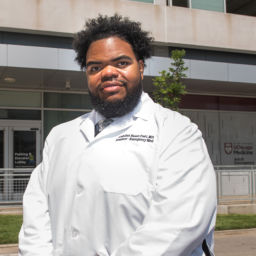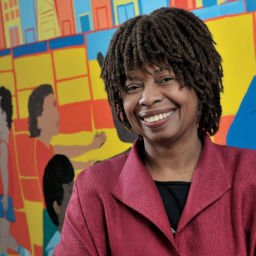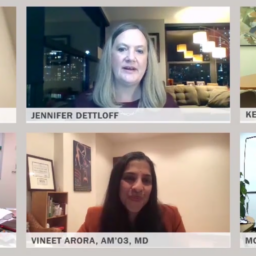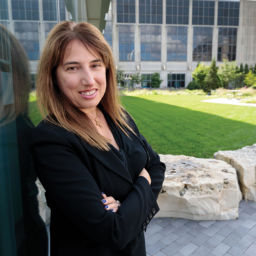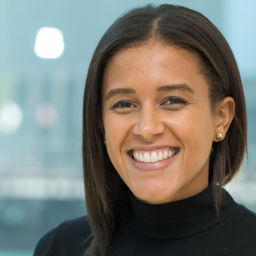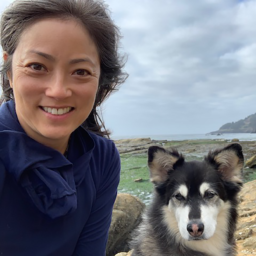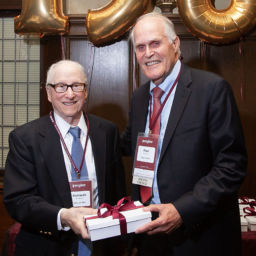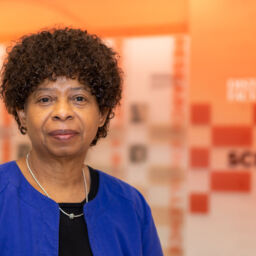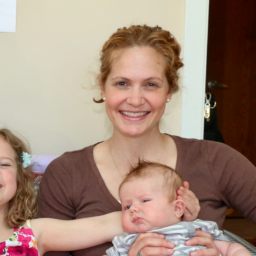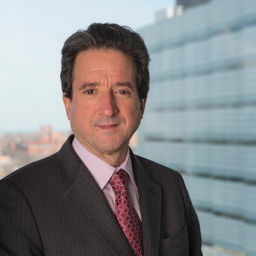by Kate Dohner
William McDade, PhD’88, MD’90, Chief Diversity, Equity and Inclusion Officer for the Accreditation Council for Graduate Medical Education (ACGME), and Courtney Amegashie, a third-year student at the University of Chicago Pritzker School of Medicine, reflect on their experiences and share their perspectives on advancing diversity, equity and inclusion in medical education.
Courtney Amegashie: How did you first become interested in studying medicine at the University of Chicago?
William McDade: I grew up on Chicago’s South Side. During the summer before my third year at DePaul University, I talked with Don Steiner, SM’56, MD’56, a biochemist at the University of Chicago who discovered proinsulin. Dr. Steiner arranged a meeting for me with Joseph Ceithaml, SB’37, PhD’41, the dean of students, who recommended I pursue the Medical Scientist Training Program (MSTP) and take graduate courses during my senior year to help prepare for medical school.
On a Saturday morning in April, I remember getting a call from Dean Ceithaml, telling me I’d been admitted to the MSTP. To be told I would have the opportunity to pursue my education at UChicago was really quite a thrill.
Amegashie: Once you got to Pritzker, what was your experience like?
McDade: During the summer, we studied anatomy, and I took a course with Albert Dorfman, MD, PhD, which was amazing because he was one of the pillars of pediatric endocrinology.
James Bowman, MD, who was the only African American faculty member at that time, recommended I study sickle cell disease. He said there were very few African Americans with my background in chemistry and physics who could do the structural work to understand the disease at the molecular level. So I took his advice and had a wonderful experience in the lab working with Robert Josephs, PhD.
Years after I completed my training, I reflected on the fact that I was the only African American student in my entering class and did some research to see if there were other Black students who had completed the program. Although I was the first Black student to graduate from the MSTP, there were other Black MD-PhDs who graduated from the University in the 1940s. Discovering that gave me some degree of comfort because it meant I wasn’t the very first.
Amegashie: In my class at Pritzker today, there are 14 Black students. When I walk into the classroom, I feel fortunate because I am never the only Black student.
I also relate to your experience realizing that there were other Black students who came before you. One day, when I was walking through Mitchell Hospital, I wondered when the first Black women graduated from Pritzker. I found their pictures in the class composites, and now I think about them whenever I walk through the hospital corridor. It’s so encouraging to think, “They did it, and I’m going to do it too.”
McDade: The University of Chicago is a special place. Very few African Americans had the opportunity to pursue education at the PhD or MD level early on. Pritzker matriculated its first class of students in 1927, and by 1932, the first African American graduated—Dr. William Moses Jones.
The period when I started medical school coincided with a backlash against affirmative action, which motivated me to become involved in recruiting and admitting more minority students. Although there were other Black medical students in the classes ahead of me, including Doriane Miller, MD’83, Catherine Harth, MD’83, and John Ellis, MD’82 — there were only a handful of us.
I helped to recruit people like Otis Brawley, SB’81, MD’85, who recently received the Distinguished Service Award from the American Medical Association, served as Chief Medical and Scientific Officer for the American Cancer Society, and is now a distinguished faculty member at Johns Hopkins. When I returned to join the University of Chicago faculty, I joined the Pritzker admissions committee, which I served on for 17 years.
When I first joined the committee, we admitted 12 underrepresented minority students. By my last year, we admitted 21. It was exciting to see the progress. The best part was recruiting minority students like you who were exceptional. The work being done by the committee today is incredible. It’s a delight to see that the efforts I was so invested in are not only continuing, but are improving.
Amegashie: That’s wonderful. I understand that you previously served as deputy provost for research and minority issues and associate dean for minority affairs for the University of Chicago. Can you share more about your experience in those roles?
McDade: When I came on as associate dean, I learned that many of our minority students didn’t understand what health disparities were—even though they may have been victims of a system that allowed such disparities to persist. So we started teaching students about health disparities.
While it’s important to train everyone on the elimination of health disparities and culturally competent care, it’s especially important to train those who are going to practice in underserved areas, and the data shows that underrepresented minorities are more likely to do so. The AAMC’s matriculation survey found that 60 percent of first-year African American medical students said they plan to work in underserved areas, compared to much lower percentages among white and Asian students. So it’s important that we develop a workforce that has a greater tendency to practice in underrepresented communities that face the greatest burden of disparities.
Amegashie: That makes sense. I imagine trust also plays a role when it comes to patients in underserved communities accessing care.
McDade: Yes, walls of mistrust have built up over centuries between African Americans and the medical establishment as a result of historical abuses, including the controversial experiments Marion Sims did on enslaved women, the Tuskegee experiment and the “Mississippi appendectomy.”
Trust is tied to better outcomes. Owen Garrick, MD, and Marcella Alsan, MD, PhD, published a paper in 2018 in which they found that, when a Black male patient was randomly assigned to a Black physician, the patient talked more to the physician, and the physician wrote longer notes compared to non-Black physicians. Black physicians were also more successful in getting patients to agree to invasive testing. Patients in racially concordant pairings were also more likely to return for follow-up visits. Their work also suggested that racially concordant patient-provider relationships could reduce the gap between Blacks and whites in cardiovascular morbidity by nearly 20 percent and mortality by nearly 10 percent.
Research also shows that minority physicians care for a disproportionate number of people in minority communities. African American physicians have a 23-fold greater chance of caring for African American patients than white physicians. Within primary care, the odds increase to 40-fold. So concordant racial patterns exist in practice in healthcare already, even though we don’t tell patients which doctor to see or physicians where to practice.
Most recently, a paper in the Proceedings of the National Academy of Sciences showed that Black newborns, who die at three times the rate of white newborns when cared for by white physicians, are more than twice as likely to survive when cared for by Black doctors.
Putting all of this together, it becomes apparent that racially concordant relationships can save Black lives.
Amegashie: How has this translated to the work you’re doing at the ACGME?
McDade: We are working to ensure that residency programs have inclusive environments that support underrepresented students, and that we remove barriers that may have caused minority residents not to be as successful.
I’m applying my understanding of Kaplan-Meier survival curves to resident success, comparing the loss of minority residents during the course of their training to non-minority residents. When you look at the data, it breaks your heart because you see that minority residents could be lost at any stage. In anesthesia, if you’re a Black resident, you are 10 times more likely to be dismissed from your program compared to a white resident. In internal medicine, the risk is 12-fold, and in orthopaedic surgery, it’s 31-fold.
Amegashie: As a Black woman in medicine and a first-generation college student, I am so grateful for the work you’re doing. As it pertains to diversity in medical education, where would you say we are now, and where do you think we’re headed?
McDade: We’re at the very beginning in graduate medical education; we’re still identifying the problems. At the ACGME, we’re engaging in reverse ideation — instead of thinking about deficits that the learner brings to medical education, we’re examining how we, as a system, contribute to a learning environment that adversely impacts minority residents. Once we understand that, we can find ways to improve the environment to allow underrepresented residents to flourish.
We’re also developing resources that graduate medical education programs can use and are building learning committees across the country, where people can apply these ideas at their institutions and identify ways to remove barriers.
I’m also advocating for the creation of associate or vice deans for diversity in graduate medical education. Most institutions don’t have a physician-leader focused on increasing diversity and working to establish inclusive learning environments for their graduate medical education programs.
At UChicago, you are fortunate because Anita Blanchard, MD’90, is the ACGME’s designated institutional official and works with us to set the academic policy for programs as a member of the OB-Gyn Residency Review Council. She is one of only about 15 African American designated institutional officials in the country out of the 800 institutions ACGME accredits.
Amegashie: Why do you think minority residents may not be as successful compared to their peers?
McDade: There are a number of studies that have investigated this. Dowin Boatright, MD, and colleagues at Yale examined the microaggressions that minority residents are subjected to in their programs and published this in JAMA Internal Medicine this year. He found that African American women are the victims of more microaggressions and discrimination than any other group, which may be the result of the intersectionality of race and gender.
Lotte Dyrbye, MD, at Mayo Clinic found that victims of discrimination have an accelerated path to depression and burnout, leading to feelings of apathy and hopelessness, difficulty concentrating, and poorer job performance. This can cause minority residents to receive poorer evaluations compared to their peers. That is why it is important that we recognize the biases in our learning environments and take down barriers.
Amegashie: That is huge. Dr. McDade, what do you think most people misunderstand when it comes to diversity and equity?
McDade: I think the word diversity is problematic because people want to argue about what it means. I’ve adopted the Association of American Medical Colleges’ definition, which includes all aspects of human differences — from socioeconomic status to race and ethnicity to ability, gender identity, age and more. Diversity is however you wish to define it in your environment. However, what is critical to me is that, by increasing whichever aspect of diversity you set your goals upon, you positively impact health disparities in your community.
The second misunderstanding is related to equity. Some people assume it means the same thing as equality. Equity is when you give people what they need in order to be successful. People who’ve been privileged with advantages in the past probably don’t need as much help as people who have suffered continued disadvantages. It differs from equality, which implies that everyone should be treated the same way.
Amegashie: I imagine we are thinking of the same image where a group of people are watching a baseball game and trying to see over the fence. When everyone is given the same size box to stand on, that is equality, but still, not everyone can see the game. By contrast, when each person is given a different number of boxes to stand on, in accordance to their height, then they can all see the game—that is equity.
McDade: Exactly. And you might recall that in the last picture, the fence is gone. You’ve removed the systemic barrier. That’s where we need to be when looking at our institutions, which are often the sources of the problems.
Amegashie: I agree. Removing those structural barriers represents the future.



